
|
It brightened up to 8 mag from 2022 summer to 2023 spring. Now it is 10.4 mag (May 19, Thomas Lehmann). Fading slowly. In the Northern Hemisphere, it is not observable now, but it will appear in August. It locates somewhat low in the Southern Hemisphere. But it will become high in summer.
Date(TT) R.A. (2000) Decl. Delta r Elong. m1 Best Time(A, h)
June 3 5 27.87 -16 5.3 3.411 2.712 39 9.9 20:53 ( 95,-36)
June 10 5 36.49 -14 42.6 3.499 2.773 38 10.0 20:58 (101,-40)
|
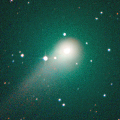
|
Now it is 10.6 mag (Apr. 9, Ken-ichi Kadota). It stays 10 mag for a while. In the Northern Hemisphere, it will be unobservable soon. But it will be observable again in June. In the Southern Hemisphere, it will be getting higher gradually.
Date(TT) R.A. (2000) Decl. Delta r Elong. m1 Best Time(A, h)
June 3 2 56.50 20 41.7 3.131 2.247 24 10.0 3:02 (243, -2)
June 10 3 0.45 19 25.3 3.075 2.259 30 10.0 3:00 (247, 1)
|
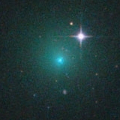
|
It brightened very rapidly. Now it is 11.5 mag (May 31, Osamu Miyazaki). It will turn to fade out rapidly after brightening. In the Northern Hemisphere, it stays observable in good condition. In the Southern Hemisphere, it is not observable now, but it will appear in August.
Date(TT) R.A. (2000) Decl. Delta r Elong. m1 Best Time(A, h)
June 3 12 23.35 69 42.8 0.754 1.125 77 10.5 20:53 (169, 54)
June 10 12 38.13 72 21.2 0.737 1.084 74 10.1 20:58 (169, 51)
|
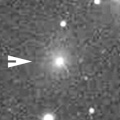
|
It is expected to brighten up to 8 mag in July. Now it is 11.1 mag (May 20, Thomas Lehmann). Brightening gradually. It stays extremely low in the Northern Hemisphere. But it will become high in winter. In the Southern Hemisphere, it stays observable in good condition. At the high light, it will be observable in excellent condition in the Southern Hemisphere, but it will be very low in the Northern Hemisphere.
Date(TT) R.A. (2000) Decl. Delta r Elong. m1 Best Time(A, h)
June 3 0 42.90 -14 19.7 1.769 1.693 68 11.0 3:02 (291, 4)
June 10 0 40.37 -16 8.4 1.555 1.649 76 10.6 3:00 (296, 8)
|
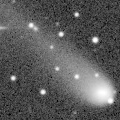
|
Now it is 12.1 mag (May 24, Osamu Miyazaki). It stays 13 mag for a while. It will be unobservable in July in the Northern Hemisphere, or in August in the Southern Hemisphere. But it will be observable again in September in the Southern Hemisphere.
Date(TT) R.A. (2000) Decl. Delta r Elong. m1 Best Time(A, h)
June 3 10 26.35 -5 1.2 3.557 3.672 88 12.0 20:53 ( 59, 29)
June 10 10 23.56 -5 34.4 3.693 3.682 81 12.1 20:58 ( 65, 23)
|
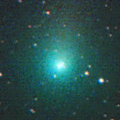
|
It brightened up to 9.5 mag from winter to early spring (Jan. 30, Katsumi Yoshimoto). Now it is 12.1 mag (May 31, Osamu Miyazaki). Fading gradually. In the Northern Hemisphere, it stays observable in good condition. It locates somewhat low in the Southern Hemisphere. But it will become high in summer.
Date(TT) R.A. (2000) Decl. Delta r Elong. m1 Best Time(A, h)
June 3 0 56.04 36 33.9 2.693 2.191 50 12.3 3:02 (243, 29)
June 10 0 58.45 35 56.1 2.659 2.244 55 12.4 3:00 (246, 33)
|

|
Now it is 12.5 mag (May 23, Chris Wyatt). Fading slowly. In the Northern Hemisphere, it is not observable now. In the Southern Hemisphere, it stays observable in good condition. It was expected to brighten up to 10 mag from spring to summer. However, it is fainter than originally expected.
Date(TT) R.A. (2000) Decl. Delta r Elong. m1 Best Time(A, h)
June 3 21 8.97 -73 52.7 2.479 3.083 117 12.3 3:02 (354,-20)
June 10 21 10.20 -77 45.2 2.472 3.089 118 12.3 3:00 (356,-23)
|
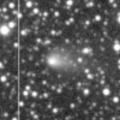
|
It brightened very rapidly as expected. Now it is 12.5 mag (May 31, Osamu Miyazaki). It will fade out rapidly after this. It stays observable in good condition.
Date(TT) R.A. (2000) Decl. Delta r Elong. m1 Best Time(A, h)
June 3 20 0.34 -7 20.1 1.184 1.993 129 12.3 3:02 (355, 48)
June 10 20 0.98 -5 43.1 1.144 1.998 135 12.3 2:50 ( 0, 49)
|

|
It is expected to brighten up to 11 mag in July. Now it is 15.0 mag (May 25, Thomas Lehmann). It will turn to fade out rapidly after brightening. It stays extremely low. But it will become high in autumn in the Northern Hemisphere, or in autumn in the Northern Hemisphere. Recently it is much fainter than this ephemeris.
Date(TT) R.A. (2000) Decl. Delta r Elong. m1 Best Time(A, h)
June 3 1 29.85 17 26.4 1.545 1.098 45 13.6 3:02 (258, 13)
June 10 2 3.84 19 20.5 1.519 1.048 43 13.0 3:00 (255, 12)
|
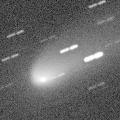
|
Now it is 12.0 mag (May 24, Osamu Miyazaki). It will fade out rapidly after this. It stays observable in good condition.
Date(TT) R.A. (2000) Decl. Delta r Elong. m1 Best Time(A, h)
June 3 17 28.13 -18 14.6 1.243 2.246 168 13.1 0:46 ( 0, 37)
June 10 17 21.09 -18 17.3 1.274 2.286 174 13.2 0:11 ( 0, 37)
|
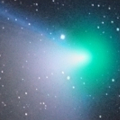
|
It approached to Earth down to 0.29 a.u. in early February, and it brightened up to 4.5 mag (Feb. 1, Juan Jose Gonzalez). Now it is 12.2 mag (May 21, Thomas Lehmann). Fading gradually. In the Northern Hemisphere, it is not observable now, but it will appear in September. In the Southern Hemisphere, it will be getting higher gradually.
Date(TT) R.A. (2000) Decl. Delta r Elong. m1 Best Time(A, h)
June 3 5 42.02 -15 55.9 3.042 2.370 40 13.2 20:53 ( 93,-33)
June 10 5 47.89 -17 2.8 3.124 2.451 41 13.4 20:58 ( 96,-39)
|
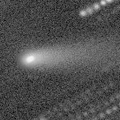
|
It approached to Earth down to 0.12 a.u. in April, and brightened up to 11.5 mag (Apr. 8, Osamu Miyazaki). Now it is 12.9 mag (May 20, Jose Guilherme de S. Aguiar). Fading rapidly. It will be fainter than 18 mag in July. In the Northern Hemisphere, it will be getting higher gradually. In the Southern Hemisphere, it stays observable in good condition.
Date(TT) R.A. (2000) Decl. Delta r Elong. m1 Best Time(A, h)
June 3 1 19.58 -6 57.8 0.677 0.864 57 13.2 3:02 (279, 1)
June 10 1 34.27 -5 45.0 0.745 0.911 60 13.9 3:00 (280, 4)
|

|
It brightened up to 8.3 mag in 2021-2022 winter (Jan. 6, 2022, Toshiyuki Takahashi). Now it is 12.7 mag (May 23, Chris Wyatt). Fading slowly. In the Northern Hemisphere, it is not observable now. In the Southern Hemisphere, it will be getting lower gradually. But it will be getting higher again after September.
Date(TT) R.A. (2000) Decl. Delta r Elong. m1 Best Time(A, h)
June 3 9 16.56 -30 10.4 5.684 5.673 84 13.2 20:53 ( 52, 0)
June 10 9 20.63 -30 3.0 5.803 5.717 80 13.4 20:58 ( 56, -5)
|
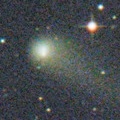
|
It brightened up to 11.1 mag in early 2022 (Mar. 31, 2022, F. Kugel, J.-G. Bosch, J. Nicolas). Now it is 13.3 mag (May 23, Chris Wyatt). Fading slowly. It stays observable in good condition.
Date(TT) R.A. (2000) Decl. Delta r Elong. m1 Best Time(A, h)
June 3 15 19.79 21 20.9 4.424 5.159 132 13.5 22:33 ( 0, 76)
June 10 15 17.30 21 38.5 4.509 5.191 127 13.6 22:03 ( 0, 77)
|
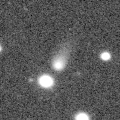
|
It is expected to brighten up to 7 mag in early 2024. Now it is 14.2 mag (May 17, ATLAS Chile). Brightening gradually. In the Northern Hemisphere, it is not observable now. It locates somewhat low in the Southern Hemisphere. But it will become high in winter.
Date(TT) R.A. (2000) Decl. Delta r Elong. m1 Best Time(A, h)
June 3 6 20.50 -23 57.1 4.119 3.585 52 13.6 20:53 ( 80,-29)
June 10 6 29.82 -23 41.3 4.071 3.514 50 13.5 20:58 ( 83,-34)
|

|
The brightness evolution is slower than originally predicted. Now it is 13.4 mag (May 19, Thomas Lehmann). Fading slowly. In the Northern Hemisphere, it is not observable now. It locates somewhat low in the Southern Hemisphere. But it will become high in winter.
Date(TT) R.A. (2000) Decl. Delta r Elong. m1 Best Time(A, h)
June 3 5 56.40 -30 57.9 2.458 2.072 56 14.0 20:53 ( 75,-37)
June 10 6 15.15 -32 38.6 2.448 2.090 57 14.0 20:58 ( 74,-40)
|
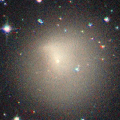
|
Now it is 14.6 mag (May 9, Ken-ichi Kadota). It stays 14 mag for a while. It will be unobservable soon. But it will be observable again in August.
Date(TT) R.A. (2000) Decl. Delta r Elong. m1 Best Time(A, h)
June 3 6 59.58 26 7.7 6.945 6.105 31 14.1 20:53 (117, 7)
June 10 7 5.05 25 54.6 7.001 6.107 26 14.1 20:58 (120, 2)
|
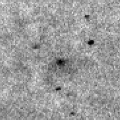
|
Now it is 13.7 mag (May 20, Jose Guilherme de S. Aguiar). Fading slowly. In the Northern Hemisphere, it will be getting higher gradually. In the Southern Hemisphere, it stays observable in good condition.
Date(TT) R.A. (2000) Decl. Delta r Elong. m1 Best Time(A, h)
June 3 0 29.49 -6 19.8 2.138 1.992 67 14.2 3:02 (286, 12)
June 10 0 40.48 -5 25.0 2.104 2.028 71 14.3 3:00 (288, 15)
|
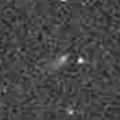
|
It will brighten rapidly up to 13.5 mag in summer. Now it is 15 mag (May 19, Giuseppe Pappa). It stays 14 mag for a while. In the Northern Hemisphere, it will be getting higher gradually. In the Southern Hemisphere, it will be getting lower gradually after this, and it will be unobservable in September.
Date(TT) R.A. (2000) Decl. Delta r Elong. m1 Best Time(A, h)
June 3 1 9.53 -6 55.5 2.028 1.747 59 14.4 3:02 (281, 3)
June 10 1 20.16 -3 38.3 1.959 1.733 62 14.2 3:00 (280, 8)
|
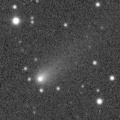
|
Now it is 14.3 mag (May 23, Chris Wyatt). Fading gradually. In the Northern Hemisphere, it will be unobservable in August. In the Southern Hemisphere, it stays observable in good condition.
Date(TT) R.A. (2000) Decl. Delta r Elong. m1 Best Time(A, h)
June 3 13 23.64 -32 20.0 1.553 2.383 135 14.4 20:53 ( 4, 22)
June 10 13 22.14 -32 31.8 1.617 2.391 129 14.5 20:58 ( 11, 21)
|
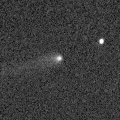
|
Now it is 14.9 mag (Mar. 19, Masayoshi Yoshimi). It stays 14 mag for a while. In the Northern Hemisphere, it is not observable now, but it will be observable soon. In the Southern Hemisphere, it will be getting higher gradually.
Date(TT) R.A. (2000) Decl. Delta r Elong. m1 Best Time(A, h)
June 3 2 43.02 3 11.0 4.019 3.234 34 14.6 3:02 (259,-10)
June 10 2 43.39 3 49.8 3.943 3.236 40 14.6 3:00 (262, -5)
|
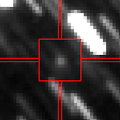
|
Now it is 16.2 mag (May 15, ATLAS Chile). It stays 15 mag for a while. It locates somewhat low in the Northern Hemisphere. In the Southern Hemisphere, it stays observable in good condition. It is fainter than this ephemeris recently.
Date(TT) R.A. (2000) Decl. Delta r Elong. m1 Best Time(A, h)
June 3 18 30.33 -20 43.7 1.999 2.948 154 14.7 1:48 ( 0, 34)
June 10 18 26.56 -21 46.8 1.957 2.940 162 14.7 1:17 ( 0, 33)
|
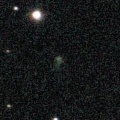
|
It will brighten up to 13 mag in summer. Now it is 14.7 mag (May 28, Thomas Lehmann). It will turn to fade out rapidly after brightening. In the Northern Hemisphere, it stays observable in good condition. In the Southern Hemisphere, it is not observable now, but it will appear in August.
Date(TT) R.A. (2000) Decl. Delta r Elong. m1 Best Time(A, h)
June 3 1 49.06 63 38.3 1.843 1.427 50 14.9 3:02 (211, 30)
June 10 1 39.92 64 5.0 1.754 1.410 53 14.7 3:00 (211, 34)
|
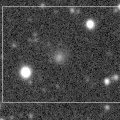
|
Now it is 15.2 mag (May 24, Ken-ichi Kadota). It stays 15 mag for a while. It stays observable in good condition. It is expected to brighten up to 12.5 mag in 2024 spring. At the high light, it will be observable in excellent condition in the Southern Hemisphere, but it will be low in the Northern Hemisphere.
Date(TT) R.A. (2000) Decl. Delta r Elong. m1 Best Time(A, h)
June 3 17 17.48 23 0.4 3.155 3.927 133 15.0 0:35 ( 0, 78)
June 10 17 3.38 22 42.5 3.101 3.879 134 14.9 23:48 ( 0, 78)
|
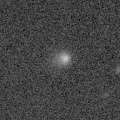
|
Now it is 15.5 mag (May 31, ATLAS Chile). It stays 15 mag for a while. It will be unobservable soon in the Northern Hemisphere, or in August in the Southern Hemisphere. But it will be observable again in September. It is expected to brighten up to 12 mag from 2024 to 2025.
Date(TT) R.A. (2000) Decl. Delta r Elong. m1 Best Time(A, h)
June 3 8 55.33 -1 0.3 5.792 5.459 65 15.2 20:53 ( 78, 15)
June 10 8 56.36 -0 20.3 5.859 5.417 59 15.2 20:58 ( 83, 9)
|
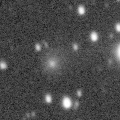
|
It will brighten up to 14 mag from 2024 to 2025. Now it is 15.4 mag (May 20, Thomas Lehmann). It stays 15 mag for a while. In the Northern Hemisphere, it is not observable now. In the Southern Hemisphere, it will be getting lower gradually. But it will be getting higher again after September.
Date(TT) R.A. (2000) Decl. Delta r Elong. m1 Best Time(A, h)
June 3 9 5.68 -28 53.5 6.161 6.095 81 15.3 20:53 ( 54, -1)
June 10 9 10.50 -28 23.3 6.207 6.066 77 15.3 20:58 ( 59, -5)
|
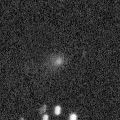
|
Rob Matson discovered it as a bright new comet as 11 mag from SWAN images between Apr. 5 and 15. It was revealed to be an asteroid which has been observed also in 2012 and 2018. It approached to Sun down to 0.5 a.u. on Mar. 29. Now it is 16.5 mag (May 13, iTelescope Deep Sky Chile, Rio Hurtado). Fading rapidly. It will be fainter than 18 mag in July. In the Northern Hemisphere, it is not observable now, but it will be observable soon. In the Southern Hemisphere, it stays observable in good condition.
Date(TT) R.A. (2000) Decl. Delta r Elong. m1 Best Time(A, h)
June 3 15 31.68 -77 4.8 0.436 1.311 124 15.4 22:46 ( 0,-21)
June 10 15 29.45 -65 29.0 0.494 1.406 134 15.9 22:17 ( 0,-10)
|

|
Now it is 15.9 mag (May 25, Thomas Lehmann). It stays 15 mag for a while. In the Northern Hemisphere, it will be getting higher gradually. In the Southern Hemisphere, it stays observable in good condition.
Date(TT) R.A. (2000) Decl. Delta r Elong. m1 Best Time(A, h)
June 3 0 18.62 -6 34.6 3.627 3.423 70 15.4 3:02 (288, 14)
June 10 0 24.62 -6 6.0 3.548 3.437 75 15.4 3:00 (291, 18)
|
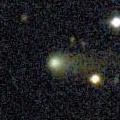
|
Now it is 15.8 mag (May 23, Toshihiko Ikemura, Hirohisa Sato). Fading slowly. It will be unobservable in August in the Southern Hemisphere, or in September in the Northern Hemisphere.
Date(TT) R.A. (2000) Decl. Delta r Elong. m1 Best Time(A, h)
June 3 10 10.49 26 15.9 3.679 3.533 73 15.5 20:53 ( 94, 45)
June 10 10 18.37 25 34.9 3.784 3.553 69 15.6 20:58 ( 96, 39)
|

|
It brightened up to 13.4 mag in last summer (July 7, Giuseppe Pappa). Now it is 15.6 mag (May 25, Thomas Lehmann). Fading slowly. In the Northern Hemisphere, it stays observable in good condition. In the Southern Hemisphere, it will be unobservable in October.
Date(TT) R.A. (2000) Decl. Delta r Elong. m1 Best Time(A, h)
June 3 16 38.21 31 41.2 3.206 3.891 126 15.7 23:50 ( 0, 87)
June 10 16 26.00 32 44.2 3.283 3.934 123 15.8 23:11 ( 0, 88)
|
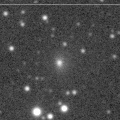
|
Brightened rapidly. It continues brightening even after the perihelion passage. Now it is 14.9 mag (May 16, Toshihiko Ikemura, Hirohisa Sato). It will fade out rapidly after this. It will be fainter than 18 mag in July. It stays observable in good condition.
Date(TT) R.A. (2000) Decl. Delta r Elong. m1 Best Time(A, h)
June 3 13 5.51 -3 30.8 1.300 2.052 124 15.7 20:53 ( 13, 51)
June 10 13 14.25 -1 28.3 1.411 2.099 118 16.0 20:58 ( 23, 51)
|
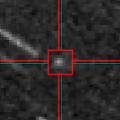
|
It is expected to brighten up to 7.5 mag in October, and it will be observable in excellent condition. Now it is 17.1 mag (May 21, Thomas Lehmann). It will brighten rapidly after this. In the Northern Hemisphere, it stays observable in good condition. In the Southern Hemisphere, it will be getting lower gradually. But it will be getting higher again after September. In the Southern Hemisphere, it becomes low temporarily around the high light.
Date(TT) R.A. (2000) Decl. Delta r Elong. m1 Best Time(A, h)
June 3 22 9.08 6 34.9 1.583 1.952 94 16.3 3:02 (302, 47)
June 10 22 20.49 8 41.5 1.461 1.890 97 15.8 3:00 (304, 50)
|

|
It will brighten up to 16 mag in June. Now it is 17.3 mag (May 18, iTelescope Deep Sky Chile, Rio Hurtado). It will fade out rapidly after this. It will be fainter than 18 mag in July. In the Northern Hemisphere, it is not observable now, but it will appear in July. In the Southern Hemisphere, it will be unobservable in July. In its last apparition in 2014, it was re-observed after 36-year blank.
Date(TT) R.A. (2000) Decl. Delta r Elong. m1 Best Time(A, h)
June 3 2 22.06 10 2.9 1.385 0.813 35 16.1 3:02 (257, -1)
June 10 2 58.43 14 21.1 1.429 0.788 32 15.9 3:00 (252, -1)
|
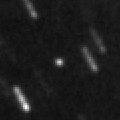
|
It will approach to Sun down to 0.4 a.u. in late September in 2024, and it is expected to brighten up to 0 mag. Now it is 16.5 mag (May 21, Katsumi Yoshimoto). It stays 16 mag for a while. It stays observable in good condition. At the high light, in the Northern Hemisphere, it will be observable in good condition after the perihelion passage. In the Southern Hemisphere, it will be observable in the low sky before and after the perihelion passage.
Date(TT) R.A. (2000) Decl. Delta r Elong. m1 Best Time(A, h)
June 3 14 27.41 3 15.8 5.609 6.404 138 16.3 21:41 ( 0, 58)
June 10 14 22.83 3 19.8 5.621 6.339 131 16.3 21:09 ( 0, 58)
|
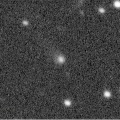
|
Now it is 16.7 mag (May 9, Masayoshi Yoshimi). It stays 16 mag for a while. It stays extremely low in the Northern Hemisphere. In the Southern Hemisphere, it will be getting lower gradually. But it will be getting higher again after August.
Date(TT) R.A. (2000) Decl. Delta r Elong. m1 Best Time(A, h)
June 3 8 22.31 -10 56.0 4.194 3.849 63 16.5 20:53 ( 75, 2)
June 10 8 24.58 -11 34.4 4.259 3.832 58 16.5 20:58 ( 79, -4)
|
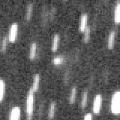
|
It returns for the first time in 70 years. It will brighten up to 4.5 mag in 2024 spring. Now it is 16.9 mag (May 25, Ken-ichi Kadota). Brightening gradually. In the Northern Hemisphere, it stays observable in good condition. In the Southern Hemisphere, it will be unobservable in July.
Date(TT) R.A. (2000) Decl. Delta r Elong. m1 Best Time(A, h)
June 3 19 23.45 49 49.5 4.075 4.359 99 16.7 2:40 (180, 75)
June 10 19 17.12 51 14.9 3.984 4.291 100 16.5 2:06 (180, 74)
|
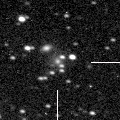
|
Very far object. Now it is 17.0 mag (May 11, ATLAS South Africa). It stays 17 mag for a while. In the Northern Hemisphere, it is not observable now. In the Southern Hemisphere, it stays observable in good condition.
Date(TT) R.A. (2000) Decl. Delta r Elong. m1 Best Time(A, h)
June 3 5 16.59 -67 14.1 10.307 10.351 89 16.8 20:53 ( 27,-46)
June 10 5 20.32 -67 11.0 10.295 10.348 90 16.8 20:58 ( 25,-48)
|
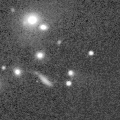
|
Now it is 17.4 mag (June 1, ATLAS-HKO, Haleakala). It stays 17 mag for a while. In the Northern Hemisphere, it stays observable in good condition. It stays extremely low in the Southern Hemisphere.
Date(TT) R.A. (2000) Decl. Delta r Elong. m1 Best Time(A, h)
June 3 13 5.01 53 24.8 2.765 2.964 91 16.8 20:53 (164, 71)
June 10 13 9.12 52 14.0 2.800 2.950 88 16.8 20:58 (151, 70)
|
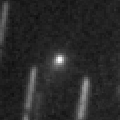
|
The ATLAS search program detected its cometary activity in April. Now it is 16.4 mag (May 29, ATLAS South Africa). It stays 17 mag for a while. It locates somewhat low in the Northern Hemisphere. In the Southern Hemisphere, it stays observable in good condition.
Date(TT) R.A. (2000) Decl. Delta r Elong. m1 Best Time(A, h)
June 3 23 16.08 -24 20.2 2.485 2.711 91 16.9 3:02 (312, 13)
June 10 23 25.07 -24 11.4 2.419 2.721 96 16.9 3:00 (315, 15)
|
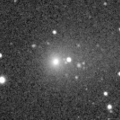
|
It brightened up to 12.4 mag in winter (Feb. 10, Taras Prystavski). Now it is 17.5 mag (May 9, Yukihiro Sugiyama). Fading gradually. It will be fainter than 18 mag in July. In the Northern Hemisphere, it will be getting lower gradually.
Date(TT) R.A. (2000) Decl. Delta r Elong. m1 Best Time(A, h)
June 3 10 6.69 16 58.5 2.424 2.388 75 16.9 20:53 ( 83, 40)
June 10 10 17.56 16 7.0 2.535 2.421 71 17.1 20:58 ( 86, 35)
|
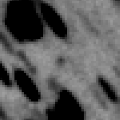
|
Now it is 16.9 mag (May 27, Jost Jahn). It stays 17 mag for a while. It stays observable in good condition.
Date(TT) R.A. (2000) Decl. Delta r Elong. m1 Best Time(A, h)
June 3 18 22.12 -12 59.4 1.908 2.856 154 17.1 1:40 ( 0, 42)
June 10 18 17.75 -12 26.3 1.855 2.833 160 17.0 1:08 ( 0, 43)
|
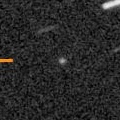
|
Now it is 17.4 mag (May 25, ATLAS-HKO, Haleakala). Fading slowly. It will be fainter than 18 mag in August. In the Northern Hemisphere, it will be getting lower gradually. It locates somewhat low in the Southern Hemisphere.
Date(TT) R.A. (2000) Decl. Delta r Elong. m1 Best Time(A, h)
June 3 9 46.43 19 35.4 2.352 2.229 70 17.0 20:53 ( 89, 37)
June 10 9 58.43 18 21.1 2.425 2.231 66 17.1 20:58 ( 91, 32)
|
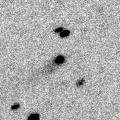
|
Now it is 17.0 mag (May 23, Toshihiko Ikemura, Hirohisa Sato). It stays 17 mag for a while. It will be getting lower gradually after this, and it will be unobservable in September.
Date(TT) R.A. (2000) Decl. Delta r Elong. m1 Best Time(A, h)
June 3 12 23.48 14 21.8 8.664 9.013 107 17.1 20:53 ( 44, 63)
June 10 12 21.12 14 26.3 8.790 9.022 100 17.1 20:58 ( 57, 58)
|

|
It brightened up to 13.6 mag in 2021 (June 17, 2021, R. Carstens). Now it is 17.6 mag (May 13, ATLAS Chile). It stays 18 mag for a while. In the Northern Hemisphere, it will never be observable after this. In the Southern Hemisphere, it stays observable in good condition.
Date(TT) R.A. (2000) Decl. Delta r Elong. m1 Best Time(A, h)
June 3 11 11.37 -67 55.7 6.138 6.605 113 17.1 20:53 ( 14,-17)
June 10 11 6.12 -66 49.2 6.212 6.638 110 17.2 20:58 ( 17,-18)
|

|
Now it is 18 mag (May 11, Giuseppe Pappa). It stays 17 mag for a while. It stays observable in good condition. It is fainter than this ephemeris recently.
Date(TT) R.A. (2000) Decl. Delta r Elong. m1 Best Time(A, h)
June 3 22 50.20 -8 10.4 2.846 3.039 91 17.3 3:02 (305, 29)
June 10 22 55.85 -8 6.9 2.751 3.037 96 17.2 3:00 (310, 32)
|
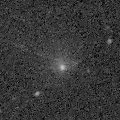
|
Very large comet. It is expected to brighten up to 14 mag in 2031. Now it is 16.3 mag (May 22, Thomas Lehmann). It stays 17 mag for a while. In the Northern Hemisphere, it is not observable now. In the Southern Hemisphere, it stays observable in good condition. In the Northern Hemisphere, it is not observable until 2030.
Date(TT) R.A. (2000) Decl. Delta r Elong. m1 Best Time(A, h)
June 3 3 9.51 -57 42.0 17.710 17.600 82 17.2 3:02 (319,-40)
June 10 3 12.56 -57 54.3 17.644 17.576 84 17.2 3:00 (320,-37)
|
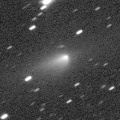
|
It brightened up to 12.7 mag in last year (Feb. 27, 2022, Jose Guilherme de S. Aguiar). Now it is 17.8 mag (May 29, ATLAS South Africa). Fading gradually. It will be fainter than 18 mag in August. It locates somewhat low in the Northern Hemisphere. In the Southern Hemisphere, it stays observable in good condition.
Date(TT) R.A. (2000) Decl. Delta r Elong. m1 Best Time(A, h)
June 3 20 6.52 -25 13.2 2.224 3.011 133 17.2 3:02 (354, 30)
June 10 20 3.87 -25 29.6 2.184 3.037 140 17.3 2:54 ( 0, 30)
|

|
It has not been observed yet in this apparition. It will brighten very rapidly, and it is expected to brighten up to 15 mag in summer. Brightening gradually. It locates somewhat low in the Northern Hemisphere. In the Southern Hemisphere, it stays observable in good condition.
Date(TT) R.A. (2000) Decl. Delta r Elong. m1 Best Time(A, h)
June 3 17 14.85 -37 56.1 1.335 2.323 162 17.6 0:33 ( 0, 17)
June 10 17 8.21 -37 37.5 1.301 2.298 165 17.2 23:54 ( 0, 17)
|
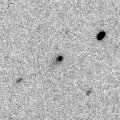
|
Now it is 17.2 mag (May 25, ATLAS-HKO, Haleakala). It stays 18 mag for a while. In the Northern Hemisphere, it will be getting lower gradually. It locates somewhat low in the Southern Hemisphere.
Date(TT) R.A. (2000) Decl. Delta r Elong. m1 Best Time(A, h)
June 3 10 9.06 28 35.3 2.619 2.514 72 17.3 20:53 ( 97, 45)
June 10 10 19.15 27 16.2 2.689 2.509 68 17.3 20:58 ( 98, 40)
|

|
It brightened up to 14.1 mag in 2022 spring (Mar. 22, 2022, Chris Wyatt). It was expected to brighten up to 13 mag. But actually, it was fainter than originally expected. It stays 17 mag for a while. In the Northern Hemisphere, it is not observable now, but it will be observable soon. In the Southern Hemisphere, it will be getting higher gradually.
Date(TT) R.A. (2000) Decl. Delta r Elong. m1 Best Time(A, h)
June 3 2 56.39 -6 8.3 5.282 4.530 38 17.3 3:02 (265,-18)
June 10 2 58.97 -5 31.5 5.266 4.574 42 17.4 3:00 (268,-13)
|
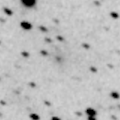
|
Now it is 17.6 mag (May 25, Ken-ichi Kadota). Fading gradually. It will be fainter than 18 mag in July. In the Northern Hemisphere, it stays observable in good condition. It locates somewhat low in the Southern Hemisphere. It looks diffuse, but it has a large coma.
Date(TT) R.A. (2000) Decl. Delta r Elong. m1 Best Time(A, h)
June 3 22 19.49 19 46.2 2.176 2.360 87 17.4 3:02 (284, 53)
June 10 22 22.48 21 50.7 2.147 2.404 91 17.5 3:00 (286, 58)
|

|
It showed cometary activity in 2023, and brightened rapidly. Now it is 17.2 mag (May 27, Jean-Claude Merlin). Fading slowly. It will be fainter than 18 mag in August. It stays extremely low in the Northern Hemisphere. In the Southern Hemisphere, it stays observable in good condition.
Date(TT) R.A. (2000) Decl. Delta r Elong. m1 Best Time(A, h)
June 3 14 18.48 -44 18.8 2.537 3.405 143 17.4 21:32 ( 0, 11)
June 10 14 16.12 -43 26.8 2.580 3.410 138 17.5 21:03 ( 0, 12)
|
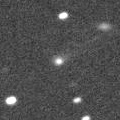
|
It brightened up to 15.9 mag in 2022 spring (May 5, Toshiyuki Takahashi). Now it is 16.8 mag (May 25, Ken-ichi Kadota). It stays 18 mag for a while. It locates somewhat low in the Northern Hemisphere. In the Southern Hemisphere, it stays observable in good condition.
Date(TT) R.A. (2000) Decl. Delta r Elong. m1 Best Time(A, h)
June 3 16 7.29 -24 19.5 3.949 4.955 171 17.6 23:21 ( 0, 31)
June 10 16 3.66 -24 11.8 3.976 4.963 164 17.6 22:50 ( 0, 31)
|

|
First return of a new periodic comet which brightened up to 15 mag in 2008. It has not been recovered yet in this apparition. It stays 18 mag for a while. In the Northern Hemisphere, it will be getting higher gradually. It locates somewhat low in the Southern Hemisphere. But it will become high in autumn.
Date(TT) R.A. (2000) Decl. Delta r Elong. m1 Best Time(A, h)
June 3 1 28.20 20 12.5 2.945 2.339 44 17.7 3:02 (255, 15)
June 10 1 42.03 20 53.1 2.898 2.345 48 17.7 3:00 (256, 17)
|
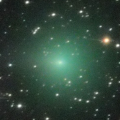
|
It brightened up to 9.7 mag in last autumn (Oct. 23, Marco Goiato). Now it is 17.3 mag (May 21, ATLAS Chile). Fading rapidly. It will be fainter than 18 mag soon. It locates somewhat low in the Northern Hemisphere. In the Southern Hemisphere, it stays observable in good condition.
Date(TT) R.A. (2000) Decl. Delta r Elong. m1 Best Time(A, h)
June 3 13 54.62 -29 2.9 1.900 2.770 141 17.7 21:07 ( 0, 26)
June 10 13 40.13 -25 57.2 2.047 2.833 132 18.1 20:58 ( 8, 29)
|

|
Now it is 17.2 mag (May 24, ATLAS-HKO, Haleakala). It stays 18 mag for a while. In the Northern Hemisphere, it stays observable in good condition. In the Southern Hemisphere, it will never be observable after this.
Date(TT) R.A. (2000) Decl. Delta r Elong. m1 Best Time(A, h)
June 3 16 47.70 80 13.5 10.156 9.987 77 17.7 0:03 (180, 45)
June 10 16 26.92 80 20.0 10.192 10.005 76 17.7 23:08 (180, 45)
|
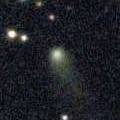
|
Now it is 17.7 mag (May 22, ATLAS-HKO, Haleakala). It stays 18 mag for a while. In the Northern Hemisphere, it stays observable in good condition. In the Southern Hemisphere, it will never be observable after this.
Date(TT) R.A. (2000) Decl. Delta r Elong. m1 Best Time(A, h)
June 3 18 42.27 63 44.1 6.537 6.630 90 17.8 1:58 (180, 61)
June 10 18 37.52 64 18.9 6.569 6.666 91 17.9 1:26 (180, 61)
|
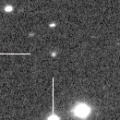
|
It will brighten up to 16 mag in 2024 spring. Now it is 18.1 mag (May 9, ATLAS South Africa). It stays 18 mag for a while. It will be unobservable soon in the Northern Hemisphere, or in August in the Southern Hemisphere. But it will be observable again in October in the Southern Hemisphere.
Date(TT) R.A. (2000) Decl. Delta r Elong. m1 Best Time(A, h)
June 3 8 57.15 -4 40.6 4.450 4.177 67 18.0 20:53 ( 75, 13)
June 10 9 3.48 -4 41.8 4.499 4.142 63 17.9 20:58 ( 79, 8)
|

|
It will brighten up to 16 mag in next winter. Now it is 18.2 mag (May 24, Ken-ichi Kadota). It stays 18 mag for a while. In the Northern Hemisphere, it will be getting lower gradually after this, and it will be unobservable in September. But it will be observable again in September. In the Southern Hemisphere, it is not observable now.
Date(TT) R.A. (2000) Decl. Delta r Elong. m1 Best Time(A, h)
June 3 12 10.05 75 29.5 2.786 2.687 73 18.0 20:53 (171, 48)
June 10 11 42.48 71 53.8 2.794 2.639 70 17.9 20:58 (163, 49)
|
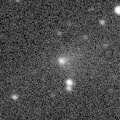
|
It approached to Sun down to 0.1 a.u. on Jan. 31. It was bright as 7.0-7.5 mag in early February (Feb. 5, Michael Jager). Now it is 16.7 mag (May 23, Toshihiko Ikemura, Hirohisa Sato). It will fade out rapidly after this. It stays observable in good condition.
Date(TT) R.A. (2000) Decl. Delta r Elong. m1 Best Time(A, h)
June 3 19 0.01 -15 16.3 1.439 2.352 146 17.9 2:18 ( 0, 40)
June 10 18 42.53 -16 20.6 1.466 2.434 157 18.2 1:33 ( 0, 39)
|
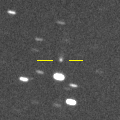
|
It was predicted to brighten up to 16 mag in 2023. But actually, it is very faint as 18.6 mag (May 3, iTelescope Deep Sky Chile, Rio Hurtado). Fading slowly. In the Northern Hemisphere, it is not observable now. In the Southern Hemisphere, it stays observable in good condition.
Date(TT) R.A. (2000) Decl. Delta r Elong. m1 Best Time(A, h)
June 3 20 53.54 -77 46.5 2.826 3.412 117 18.1 3:02 (356,-23)
June 10 20 39.53 -77 55.9 2.812 3.433 119 18.2 3:00 (358,-23)
|
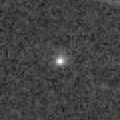
|
It was observed at 17 mag in 2022 autumn. It was predicted to be observable at 17 mag also in 2023 spring. But actually, it is extremely faint as 19.0 mag (May 16, Toshihiko Ikemura, Hirohisa Sato). It will fade out rapidly after this. It stays observable in good condition.
Date(TT) R.A. (2000) Decl. Delta r Elong. m1 Best Time(A, h)
June 3 16 10.63 25 2.4 1.448 2.258 132 20.2 23:21 ( 0, 80)
June 10 15 37.00 24 5.6 1.550 2.316 127 20.5 22:21 ( 0, 79)
|

|
In the last apparition, it had faded before the perihelion passage. It was expected to brighten up to 17 mag if it would become as bright as its last apparition. But actually, it is extremely faint as 22 mag (Apr. 8, Giuseppe Pappa). Fading slowly. It stays observable in good condition.
Date(TT) R.A. (2000) Decl. Delta r Elong. m1 Best Time(A, h)
June 3 13 44.94 6 46.1 1.928 2.675 127 21.7 20:59 ( 0, 62)
June 10 13 45.15 6 11.0 1.986 2.667 122 21.8 20:58 ( 14, 60)
|
|
![]()
 81P/Wild 2
81P/Wild 2 C/2022 E3 ( ZTF )
C/2022 E3 ( ZTF ) 364P/PanSTARRS
364P/PanSTARRS C/2019 L3 ( ATLAS )
C/2019 L3 ( ATLAS ) C/2019 T4 ( ATLAS )
C/2019 T4 ( ATLAS ) C/2021 S3 ( PanSTARRS )
C/2021 S3 ( PanSTARRS ) C/2021 Y1 ( ATLAS )
C/2021 Y1 ( ATLAS ) 29P/Schwassmann-Wachmann 1
29P/Schwassmann-Wachmann 1 71P/Clark
71P/Clark 126P/IRAS
126P/IRAS 77P/Longmore
77P/Longmore C/2021 X1 ( Maury-Attard )
C/2021 X1 ( Maury-Attard ) 199P/Shoemaker 4
199P/Shoemaker 4 C/2022 W3 ( Leonard )
C/2022 W3 ( Leonard ) C/2022 L2 ( ATLAS )
C/2022 L2 ( ATLAS ) C/2022 E2 ( ATLAS )
C/2022 E2 ( ATLAS ) C/2021 G2 ( ATLAS )
C/2021 G2 ( ATLAS ) P/2018 HT3 ( NEOWISE )
P/2018 HT3 ( NEOWISE ) 117P/Helin-Roman-Alu 1
117P/Helin-Roman-Alu 1 C/2020 S4 ( PanSTARRS )
C/2020 S4 ( PanSTARRS ) C/2020 R7 ( ATLAS )
C/2020 R7 ( ATLAS ) C/2023 B2 ( ATLAS )
C/2023 B2 ( ATLAS ) 103P/Hartley 2
103P/Hartley 2 72P/Denning-Fujikawa
72P/Denning-Fujikawa C/2023 A3 ( Tsuchinshan-ATLAS )
C/2023 A3 ( Tsuchinshan-ATLAS ) C/2022 A3 ( Lemmon-ATLAS )
C/2022 A3 ( Lemmon-ATLAS ) 12P/Pons-Brooks
12P/Pons-Brooks C/2019 E3 ( ATLAS )
C/2019 E3 ( ATLAS ) C/2022 U4 ( Bok )
C/2022 U4 ( Bok ) C/2022 JK5 ( PanSTARRS )
C/2022 JK5 ( PanSTARRS ) 118P/Shoemaker-Levy 4
118P/Shoemaker-Levy 4 219P/LINEAR
219P/LINEAR 94P/Russell 4
94P/Russell 4 C/2020 F2 ( ATLAS )
C/2020 F2 ( ATLAS ) C/2018 U1 ( Lemmon )
C/2018 U1 ( Lemmon ) 287P/Christensen
287P/Christensen C/2014 UN271 ( Bernardinelli-Bernstein )
C/2014 UN271 ( Bernardinelli-Bernstein ) 116P/Wild 4
116P/Wild 4 213P/Van Ness
213P/Van Ness 180P/NEAT
180P/NEAT C/2020 Y2 ( ATLAS )
C/2020 Y2 ( ATLAS ) 80P/Peters-Hartley
80P/Peters-Hartley P/2014 OL465 ( PanSTARRS )
P/2014 OL465 ( PanSTARRS ) 99P/Kowal 1
99P/Kowal 1 P/2008 L2 ( Hill )
P/2008 L2 ( Hill ) C/2022 P1 ( NEOWISE )
C/2022 P1 ( NEOWISE ) C/2019 O3 ( Palomar )
C/2019 O3 ( Palomar ) C/2020 H6 ( ATLAS )
C/2020 H6 ( ATLAS ) C/2022 T1 ( Lemmon )
C/2022 T1 ( Lemmon ) C/2022 V2 ( Lemmon )
C/2022 V2 ( Lemmon ) 96P/Machholz 1
96P/Machholz 1 C/2021 C5 ( PanSTARRS )
C/2021 C5 ( PanSTARRS ) C/2022 Q2 ( ATLAS )
C/2022 Q2 ( ATLAS ) 280P/Larsen
280P/Larsen![]()






















































